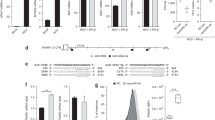Abstract
Chronic infection with hepatotropic viruses is the main cause of chronic liver disease and cirrhosis worldwide. Toll-like receptor 3 (TLR3) and Toll-like receptor 7 (TLR7) are pathogen-recognition receptors that are expressed on innate immune cells. They recognize viral RNA, which induces their activation, with a subsequent increase in type I interferon transcription. Hepatitis C virus (HCV) infection inhibits the expression of TLR3 and TLR7; however, the mechanism by which this occurs is unclear. MicroRNAs (miRNAs) are small RNAs that posttranscriptionally regulate gene expression. Their aberrant expression is commonly correlated with disease status, as is the case with HCV infection. Here, we found that miR-758 levels were increased in patients with HCV infection and were correlated with TLR3 and TLR7 expression levels in the patients with HCV infection, and bioinformatics analysis predicted that TLR3 and TLR7 are targets of miR-758. Therefore, we postulate that HCV may increase the level of miR-758, which inhibits the expression of TLR3 and TLR7, resulting in a loss of antiviral effect. In order to test our hypothesis, we constructed an HCV core protein expression plasmid and used it to transfect liver cells. The results showed that HCV infection increased miR-758 levels and decreased TLR3/TLR7 expression. Furthermore, using RT-PCR and luciferase reporter analysis, we found that miR-758 targets TLR3 and TLR7, with a subsequent decrease in IFNα and IFNβ production. In conclusion, our results highlight the upregulation of miR-758 expression by HCV as a novel mechanism contributing to downregulation of TLR3 and TLR7 in patients with HCV infection.




Similar content being viewed by others
References
Benvegnu L, Gios M, Boccato S, Alberti A (2004) Natural history of compensated viral cirrhosis: a prospective study on the incidence and hierarchy of major complications. Gut 53:744–749
Lok AS, Heathcote EJ, Hoofnagle YH (2001) Managment of hepatitis B: 2000—summary of a workshop. Gastroenterology 120:1828–1853
(1999) EASL international consensus conference on hepatitis C: Paris, 26–28 February 1999 consensus statement. J Hepatol 30:956–961
Sobesky R, Mathurin P, Charlotte F, Moussalli J, Olivi M, Vidaud M, Ratziu V, Opolon P, Poynard T (1999) Modeling the impact of interferon alfa treatment on liver fibrosis progression in chronic hepatitis C: a dynamic view. Gastroenterology 116:378–386
International Interferon-alfa Hepatocellular Carcinoma Study Group (1998) Effect of interferon-a on progression of cirrhosis to hepatocellular carcinoma: a retrospective cohort study. Lancet 351:1535–1539
Poynard T, McHutchison J, Davis GL, Esteban-Mur R, Goodman Z, Bedossa P, Albrecht J (2000) Impact of interferon alfa-2b and ribavirin on progression of liver fibrosis in patients with chronic hepatitis C. Hepatology 32:1131–1137
Hoebe K, Du X, Georgel P, Janssen E, Tabeta K, Kim SO, Goode J, Lin P, Mann N, Mudd S, Crozat K, Sovath S, Han J, Beutler B (2003) Identification of Lps2 as a key transducer of MyD88-independent TIR signalling. Nature 424:743–748
Diebold SS, Kaisho T, Hemmi H, Akira S, Reis e Sousa C (2004) Innate antiviral responses by means of TLR7-mediated recognition of single-stranded RNA. Science 303:1529–1531
Mohammed KI, Adel LA, Ali-Eldin FA, Eladawy S (2013) Expression of Toll like receptors 3 & 7 in peripheral blood from patients with chronic hepatitis C virus infection and their correlation with interferon-alpha. Egypt J Immunol 20:13–22
Sato K, Ishikawa T, Okumura A, Yamauchi T, Sato S, Ayada M, Matsumoto E, Hotta N, Oohashi T, Fukuzawa Y, Kakumu S (2007) Expression of Toll-like receptors in chronic hepatitis C virus infection. J Gastroenterol Hepatol 22(10):1627–1632
Huang YW, Lin SC, Wei SC, Hu JT, Chang HY, Huang SH, Chen DS, Chen PJ, Hsu PN, Yang SS, Kao JH (2013) Reduced Toll-like receptor 3 expression in chronic hepatitis B patients and its restoration by interferon therapy. Antivir Ther 18(7):877–884
Roberts AP, Lewis AP, Jopling CL (2011) The role of microRNAs in viral infection. Prog Mol Biol Transl Sci 102:101–139
Shrivastava S, Petrone J, Steele R, Lauer GM, Di Bisceglie AM, Ray RB (2013) Up-regulation of circulating miR-20a is correlated with hepatitis C virus-mediated liver disease progression. Hepatology 58:863–871
Shrivastava S, Mukherjee A, Ray RB (2013) Hepatitis C virus infection, microRNA and liver disease progression. World J Hepatol 5(9):479–486
Rayner KJ, Fernandez-Hernando C, Moore KJ (2012) MicroRNAs regulating lipid metabolism in atherogenesis. Thromb Haemost 107(4):642–647
Rotllan N, Fernández-Hernando C (2012) MicroRNA regulation of cholesterol metabolism. Cholesterol 2012:847849
Bartel DP (2009) MicroRNAs: target recognition and regulatory functions. Cell 136:215–233
Sarnow P, Jopling CL, Norman KL, Schutz S, Wehner KA (2006) Micro-RNAs: expression, avoidance and subversion by vertebrate viruses. Nat Rev Microbiol 4:651–659
Conrad KD, Niepmann M (2013) The role of microRNAs in hepatitis C virus RNA replication. Arch Virol (Epub ahead of print)
Ramirez CM, Dávalos A, Goedeke L, Salerno AG, Warrier N, Cirera-Salinas D, Suárez Y, Fernández-Hernando C (2011) MicroRNA-758 regulates cholesterol efflux through posttranscriptional repression of ATP-binding cassette transporter A1. Arterioscler Thromb Vasc Biol 31(11):2707–2714
Theofilopoulos AN, Baccala R, Beutler B, Kono DH (2005) Type I interferons (alpha/beta) in immunity and autoimmunity. Annu Rev Immunol 23:307–336
Conflict of interest
The authors declare that they have no conflict of interest.
Author information
Authors and Affiliations
Corresponding author
Rights and permissions
About this article
Cite this article
Yang, Q., Fu, S. & Wang, J. Hepatitis C virus infection decreases the expression of Toll-like receptors 3 and 7 via upregulation of miR-758. Arch Virol 159, 2997–3003 (2014). https://doi.org/10.1007/s00705-014-2167-3
Received:
Accepted:
Published:
Issue Date:
DOI: https://doi.org/10.1007/s00705-014-2167-3




